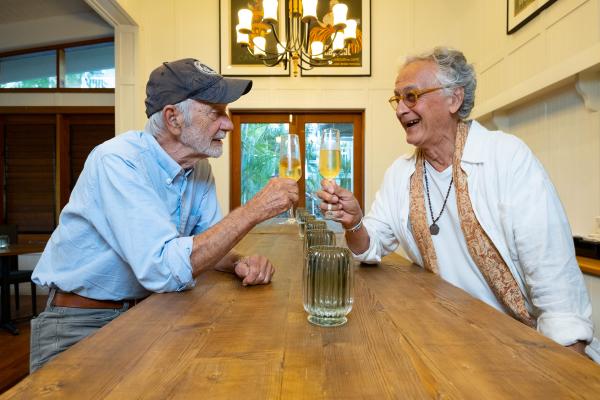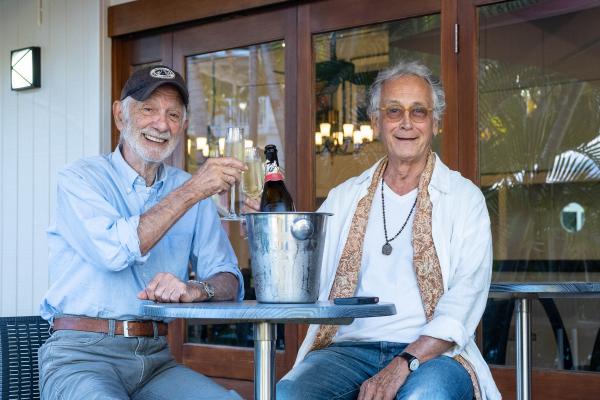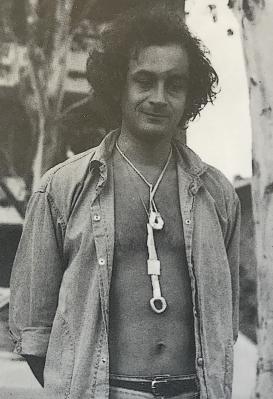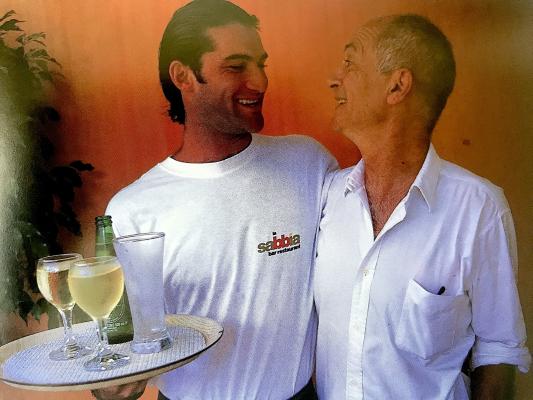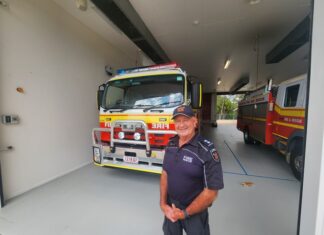In her 1996 Noosa Cook Book, restaurant pioneer Leonie Palmer writes: “What really brought me out of my inherent Australian-British food fixation was the arrival in town of two larger than life characters – Luc Turschwell, a Frenchman brought up in North Africa, and Pierre Otth, a Swiss-Frenchman – who brought with them a lifetime of culinary influences.”
This urbane yet eccentric duo was to dominate Noosa’s emerging food scene from the mid-1970s until into the new century, creating landmark establishments like Coco’s, Belmondo’s, Gaston, La Sabbia, La Plage and Caf¨¦ le Monde whose influences are still felt today.
How Luc Turschwell ended up in Noosa is a story that would fill a book, and one day it will, but not until the sprightly 79-year-old quits his current job teaching cooking. Born in Algiers in 1941, the son of a French military officer stationed in the then-French colony, his first memory is of running through the streets to a bomb shelter, but his second is the smell of his mother’s fresh-baked bread. At university he was caught up in student resistance during the war of independence and, after a pitched gun battle in the streets in which more than 40 were killed, he was forced into the army.
On his discharge in Paris, he hitch-hiked south, and in Greece he met a beautiful Australian girl called Lyn, and together they worked in an Israeli kibbutz, were robbed of their passports and savings at the Iranian border, worked their way through the subcontinent, spent Christmas 1968 on the deserted beaches of Bali, and finally made their way to Sydney, where they started a family and a successful clothing business. But the road beckoned again, and this time the plan was to drive around Australia to Perth, then ship their van to India and travel overland to France. But paradise got in the way.
Pierre Otth’s early life was equally glamorous and adventurous. Born in Lausanne after the war, he discovered cooking when he earned a merit badge for it in the Boy Scouts, and decided it would be a useful trade to have when he realized his ambition to travel the world. After an apprenticeship at the Beau-Rivage Palace, he cooked for the Aga Khan and numerous royals in St Moritz before running restaurants in London and attending the Ecole Hoteliere Lausanne. After travelling to India in a kombi, his light bulb moment came while swimming naked in Goa – this was what he wanted to do with his life!
Arriving in Australia, he ended up in a commune near Yandina, which inspired him to put his last cash into a plot of land in the Obi Obi Valley to start his own. But the need to work first brought him to a little village on the coast. Luc: When I was living in Sydney I was in the bridge world and one of the players told me about a place called Noosa Heads where I should look up a lady who was also a bridge player. By this time Lyn and I had two boys, Jean-Pierre who was two-and-a-half and Pascal who was six months. We arrived in Noosa and I discovered a restaurant called Chanson de Mer whose owner was going to France for three months and she needed a replacement chef. So I took the job.
Pierre: I drove my kombi into Noosa in 1975 and saw a place called Chez Fred. I was the most over-qualified hippie in Queensland, and when I told the guy what experience I had, he said no one could afford a fully qualified chef in Noosa. So, I kept looking and I got a job at The Grotto in Noosaville for $4 a night.
Luc: We called it the grotty Grotto because it was disgusting.
Pierre: The woman in charge was taking the fish out of the freezer in the morning and putting it back at night, so I wasn’t impressed with that. I worked there every night and every day I was at Granite Bay swimming naked. I met Luc on the beach one day and a couple of weeks later he comes up to me, we’re both naked, of course, and says that he’d been offered a restaurant but he couldn’t take it because he already had one organized in Hastings Street. He’d told the guy I’d be perfect for it.
Luc: I got him into Coco’s and he gives me 10 percent discount on the first night! (Laughs) I always call Pierre Mr 10 Percent.
Pierre: It was called Coco’s Bar and Lattice Courtyard Restaurant [actually Coco’s Palm Garden Caf¨¦], so it took me three weeks to remember the name of my own restaurant! I changed it around a bit and just called it Coco’s.
Luc: No, you called it Coco’s because at the time you were going out with a girl called Coco, you were sleeping with her in your kombi.
Pierre: Really? I don’t remember that. It had been a Japanese restaurant for a few months, operated by two lovely gay guys, but they couldn’t make it and they bolted. It was beautiful. You sat on the veranda and you could watch the moon rise over the ocean.
Luc, let’s go back to Chanson de Mer. You’d never been a chef or managed a restaurant?
Luc: No, it was an accident. The only thing I knew about cooking was my mother’s North African food, and as a student I’d worked in a few restaurants, so I told the owner, sure, let’s do it. Lyn was the waitress and I was the cook. One night a local guy took me out fishing and we caught a lot of fish, so I made a bouillabaisse and put it on the menu. Lyn comes to the kitchen door that night and says a guy wants to talk to me. I went out and he said, you made this? You must open your own restaurant in Noosa. He was a bank manager named Owen Putney but we called him Owen Plenty.
Pierre: Owen became everyone’s manager.
Luc: He was the only guy who could get money for us. I found a place on Hastings Street and got a cheap lease, put a kitchen and a courtyard in and opened Belmondo’s. It was the first time there had been tables and chairs on the street, and the council didn’t like it because they said it wasn’t hygienic. I said sorry council, this is the way we do it. A few years later they were allowing us to do it and charging royalties.
Pierre: Renting the footpath to the restaurants was my idea, I convinced the council.
Luc: In no time at all – I don’t know if it was the smell of the garlic or the chillis frying – we became very successful. Pierre would come in sometimes and tell my customers, I have a restaurant down the road, you should come!
Pierre: It was difficult because Coco’s was so far away and at night it was very dark to walk out there. But every Sunday night we had a jam session and everyone came. There’d be hippies sitting in the street outside listening to the music. I had a really good customer who used to book a table full of adults and one full of children. He came to see me one Sunday and said he had to have a table that night, but I said it’s Sunday jam session and it’s booked out already, but I said I could make him a table next to the garbage bins. Well, he came with some people that night but it was all crazy busy in the kitchen, so I didn’t take much notice. A week later people started telling me that [restaurant critic and wine merchant] Len Evans had reviewed the “world class” dishes he’d had at Coco’s. He didn’t mention the garbage bins. I didn’t even know who he was, but it worked!
Luc: Len came to Belmondo’s in a table of 10, we had Barry Charles playing so it was noisy, I didn’t know who he was either, but the following weekend there was a page on Belmondo’s in The Australian, and after that I was packed day and night.
Pierre: To be honest, before this I think the locals were not taking me seriously, just this hippie in a sarong. At the time Hastings Street had two vegetarian restaurants, a Bali shop and a bong shop. It was an alternative but progressive place to be. The mixture of different people was fascinating. Even the straight people were not that straight! We thought we could create a society of free spirits. I sold Coco’s after a few years and then I met Bill Shipton, the developer doing Noosa International on Noosa Hill, so with the help of architects Gabriel Poole and John Mainwaring, I designed a restaurant which they called Pierre’s.
Luc: At that time I was doing Belmondo’s II, which was a much bigger, modern extension of the same restaurant, where Moneypenny’s is now. And then I got a divorce and I got ripped off by a developer, so when I opened Caf¨¦ le Monde on the site of Damiani’s, I had to borrow money at 15 percent, but it was the biggest success ever in Noosa.
Pierre: After doing Pierre’s, I went to Sydney for a while, but when I came back I found my new restaurant site at a place on Hastings Street called the Bavarian Inn, just a hole in the wall, very ugly. But I knew I could make it work. My wife Colette and I bought it and stripped the whole thing, took the lederhosen off the wall and used an unused outdoor area, and we called it La Plage.
Luc: I opened La Sabbia in 1991 and had it until ’98. It was amazing. We had a pool table and live bands, and then one day some of the business guys came to me and said, this is not good for the street. I said f— you, I made the street!
Pierre: They came to me and wanted me to sign a petition against my best friend! I told them to go away.
We’re going to run out of space, so tell me about your last Noosa restaurants.
Pierre: After La Plage I got divorced and went to India to an ashram. When I came back in ‘95 I started The Boathouse in what was an old fish and chip shop. It had been a derelict squat for a long time, it was horrible and it had no zoning. The Melbourne owner sold it to me at a very reasonable price, and [mayor] Bob Abbot helped me get the zoning through council. I opened in ’97 and sold it in 2002.
Luc: Pierre put me in touch with the owners of South Pacific Resort and we designed a really cruisy space in keeping with the whole place, Hawaiian themed and called Hula Moon. I put on some great chefs, and we had a terrific time there, we looked after all the Hawaiians who came for the surfing festival.
What are your favourite memories of the Noosa you found all those years ago?
Luc: Arriving here and finding this lack of modern housing and such beautiful scenery everywhere. There were still timber shacks on Main Beach and only a couple of thousand people.
Pierre: For me Noosa represented a place that was like Goa with an idyllic lifestyle but where I could make a living. It was easy living. Coco’s didn’t even have a lock on the door, I just shoved a pot plant against it. It was paradise.

